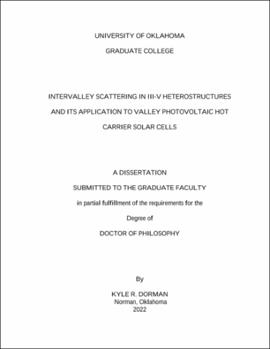| dc.contributor.advisor | Sellers, Ian | |
| dc.contributor.advisor | Santos, Michael | |
| dc.contributor.author | Dorman, Kyle | |
| dc.date.accessioned | 2022-12-05T20:45:44Z | |
| dc.date.available | 2022-12-05T20:45:44Z | |
| dc.date.issued | 2022-12-16 | |
| dc.identifier.uri | https://hdl.handle.net/11244/336871 | |
| dc.description.abstract | The efficiency limit of 33% for a single gap solar cell is not fundamental. Mitigation of thermalization losses which occur when high energy ‘hot’ carriers are only extracted at the same energy as low energy carriers is a viable route towards a solar power conversion efficiency as high as 66%. Previous efforts to develop such a hot carrier solar cell have focused on slowing thermalization through restricting electron-phonon interactions in quantum well structures. This bottleneck effect enables hot phonons to reheat the carrier distribution under high illumination powers. Despite recent success in demonstrating hot carrier effects, maintaining a population of carriers at enhanced energy under more practical conditions (room temperature and weak illumination) remains a challenge.
Here, after observing that hot carrier behavior is affected by scattering to high energy valleys of the conduction band in InAs/AlAsSb multi-quantum well structures, a more robust means of hot carrier maintenance is examined in proof-of-principle InGaAs based heterostructure devices. In these systems, photogenerated hot carriers are preferentially transferred to high energy valleys in the band structure via intervalley phonon scattering rather than thermalizing to the conduction band edge via LO phonon emission. And through inclusion of a doping profile to generate an electric field across the absorber during operation, low energy carriers can also transfer to the high energy upper valleys: the Gunn Effect.
These two mechanisms of intervalley scattering, via intervalley phonons and via the Gunn Effect, result in a simple device structure that demonstrates detectable hot carrier behavior at room temperature and at low incident illumination power. These mechanisms are investigated comprehensively through a series of structures that enable control of the electric field strength (via altered absorber thickness) to better understand how to leverage the benefits of intervalley transfer for hot carrier maintenance, and to the extraction pathway (via altered top n+ layer) to reveal how to overcome the complexities of extracting from an upper valley. While operational photovoltaic devices are yet to be realized, this work provides strong evidence for their practicality and routes toward the realization of such valley photovoltaic hot carrier solar cells. | en_US |
| dc.language | en_US | en_US |
| dc.subject | Physics, Condensed Matter. | en_US |
| dc.subject | Hot Carrier Effects | en_US |
| dc.subject | Solar Cells | en_US |
| dc.subject | Photovoltaics | en_US |
| dc.title | Intervalley Scattering in III-V Heterostructures and its Application to Valley Photovoltaic Hot Carrier Solar Cells | en_US |
| dc.contributor.committeeMember | Abraham, Eric | |
| dc.contributor.committeeMember | Mullen, Kieran | |
| dc.contributor.committeeMember | Garg, Jivtesh | |
| dc.date.manuscript | 2022-11-03 | |
| dc.thesis.degree | Ph.D. | en_US |
| ou.group | Dodge Family College of Arts and Sciences::Homer L. Dodge Department of Physics and Astronomy | en_US |
| shareok.orcid | 0000-0001-9589-7954 | en_US |
